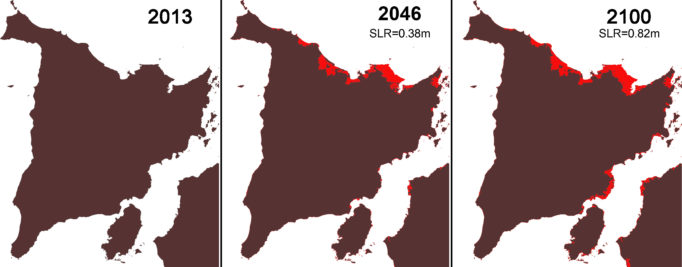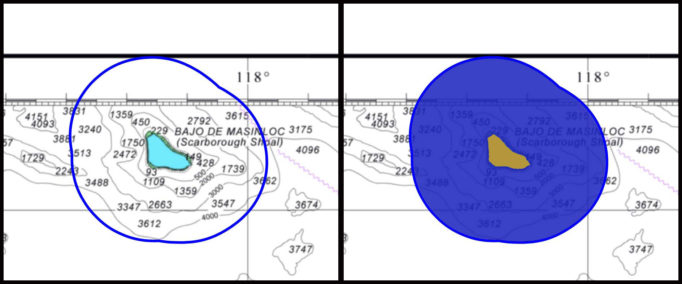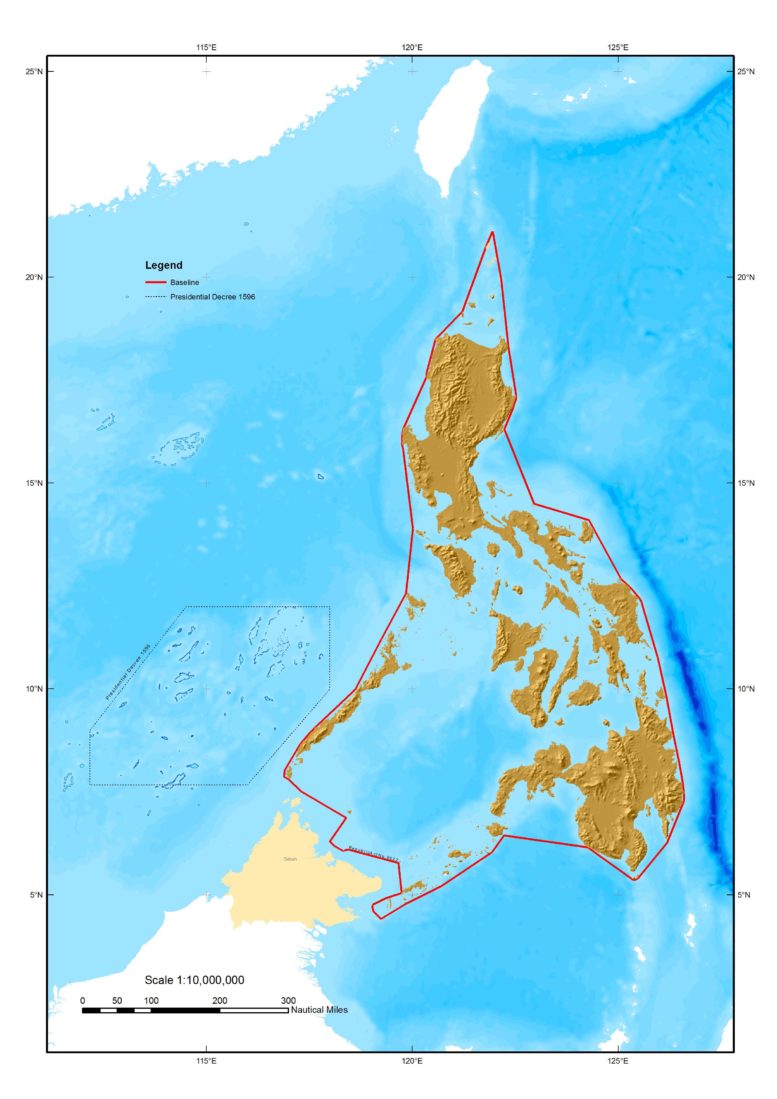The National Defense College of the Philippines defines national security as the state or condition where the sovereignty, territorial integrity, and the people’s way of life and institutions are protected and enhanced.
One of the predominant effects of climate change is rapid sea level rise. If sea level rise occurs, will it affect the sovereignty, territorial integrity, and the Filipino’s way of life?
Territory is one of the components of a nation-state. The territory is the area where the State has jurisdiction. The area where a State has sovereignty and sovereign rights are determined and measured from the baselines, which are commonly coincident with the coastline. The limits of a State’s territory are defined by the coastline – where the land meets into the sea. The adjacent sea area of the territory can also be claimed by the Coastal State as its territorial waters where it can enforce its domestic laws.
Under the United Nations Convention on the Law of the Sea (UNCLOS), a Coastal State has the right to establish the breadth of its territorial waters up to a limit not exceeding 12 nautical miles (NM) measured from the baselines. The state can also have a contiguous zone, which may not extend beyond 24 NM from the baselines from which the breadth of the territorial sea is measured. The Coastal State is further entitled to an exclusive economic zone (EEZ), which shall not extend beyond 200 nautical miles from the baselines from which the breadth of the territorial sea is measured.
In the different areas of the sea, the Coastal State and other States have certain rights under international law. The UNCLOS allows the following kinds of navigation in each maritime zone:
The UNCLOS, which is also called the Law of the Sea treaty, the baselines are the reference for all maritime zones that a Coastal State is entitled to. There are three types of baselines under the UNCLOS – normal baselines, straight baselines, and archipelagic baselines. Under RA 9522, the Philippines used archipelagic baselines for its archipelago (Luzon, Visayas and Mindanao), and normal baselines for the Kalayaan Island Group (KIG) and Bajo de Masinloc.
When sea level rise occurs, it causes change in the coastline. Naturally, the coastline will move landwards reducing the land area. The effect of sea level rise has a high impact because if the baselines would shift it will change the regime of the maritime zones measured from it. It has a subsequent effect on the implementation of local laws and the nature of navigation allowed on an area of water.
If the baselines would shift landward, an area of water that was previously considered as archipelagic water will become part of the territorial sea. A portion of the territorial sea will also become part of the EEZ, and potions of the EEZ will become part of the high seas. The authority of the Coastal State and the privilege of a foreign vessel change in the area affected.

Figure 2. Change in Panay Island due to Sea Level Rise (SLR)
The figure shows images from the model of Panay Island with SLR of 0.38m and 0.82m. The red represents the submerged areas.
The normal baseline is the actual low water line of an island or feature. Thus, it moves with the sea level. When the sea level rises, the coastline and baseline moves landward thereby reducing the land area of the island or feature. The movement also reduces the effective area of the territorial sea surrounding the island or feature. If the island or feature will be totally submerged underwater, it will lose entirely its territorial sea.
Inside the EEZ, the Coastal State has exclusive rights to fishing. In contrast, the high seas are common heritage to all. Thus, all States including land-locked States have equal rights to fishing in these areas.
If a portion of the Philippines’ EEZ becomes a part of the high seas, the way of living of Filipino fishermen will definitely be affected as they no longer would enjoy exclusivity in areas which previously were.
The Fifth Assessment Report (AR5, Table 2.1) of the Intergovernmental Panel on Climate Change (IPCC) shows that the likely range for sea level rise could go as high as 0.38 meters in 2046 and 0.82 meters in 2081-2100. Some studies suggest that sea levels could go as high as 5 meters if the Antarctic Ice Sheets melt.
Despite the attention given to climate change at present, discussions have focused generally on environmental and social impacts. The Philippines, even with its archipelagic nature, does not seem to give much discussion on how sea level rise will affect its territory and maritime zones. On the other hand, the international community is already voicing out opinions on how to address complications of shifting coastlines brought on by sea level rise.
Straight baselines are employed in localities where the coastline is deeply indented, or if there is a fringe of islands along the coast in its immediate vicinity. Archipelagic baseline is a special type of straight baseline. To be considered an archipelagic baseline, it must conform to the requirements set in UNCLOS Article 47.
Under UNCLOS, only islands or naturally formed bodies of land above water at high tide can have maritime zones. UNCLOS Article 12 states that, “an island is a naturally formed area of land, surrounded by water, which is above water at high tide.” Thus, if a feature is underwater at high tide, it is not an island and cannot have maritime zones.
Coastal States, including the Philippines, use outermost islands and drying reefs in designing their baselines in order to claim bigger maritime zones. It is expected that many, if not all, basepoints of the Philippines will submerge underwater if sea level rises. However, no one knows up to what extent the land will shift, and how much the maritime zones of the Philippines will change with such submerging of basepoints.
With this question in mind, the author generated models that will show the scenarios in 2046 and 2100 using the projection of sea level by the IPCC, and the digital terrain model from the National Mapping and Resource Information (NAMRIA) 2013 Interferometric Synthetic Aperture Radar (IfSAR) data. IfSAR is a powerful approach in generating high-resolution digital data through the use of Digital Elevation Model (DEM) and Orthorectified Radar Image (ORI).
The data extracted from the models show that the country will lose around 2,946.50 sq.km. and 6,151.52 sq.km. of land areas with a 0.38-meter and 0.82-meter sea level rise, respectively. The land area loss after 0.82-meter sea level rise is larger than the islands of Cebu and Catanduanes combined. Unlike land area, the total length of coastlines increases as sea level rises.
Aside from the effect on the land area and coastline length, sea level rise causes location of points of the archipelagic baselines to submerge permanently underwater and the normal baselines to shift landwards. The shifting of the baselines causes subsequent effect on all the maritime zones measured from it.
The question that haunts States that used archipelagic baselines is whether the submerging of locations of points joining the baselines would result to shifting of baselines and the maritime zones that are measured from them. Experts seem to have different views on this.
Arsana (2013) believes that “other types of straight line type baseline are also potentially threatened by sea level rise as such baselines need to be anchored to the coast as represented by the low water line.” This opinion conforms to the principle “the land dominates the sea” which was declared by the International Court of Justice (ICJ) in the North Continental Shelf Cases (1969). In the decision, the ICJ outlined the principle by saying, “the land is the legal source of power which a State may exercise over territorial extensions to seaward.” Thus, change in the land configuration causes change in the limits of the maritime zones.
Groups that promote fixed baselines have reference only to Article 7(2) of UNCLOS, which states “where because of the presence of a delta and other natural conditions the coastline is highly unstable, the appropriate points may be selected along the furthest seaward extent of the low-water line and, notwithstanding subsequent regression of the low-water line, the straight baselines shall remain effective until changed by the Coastal State in accordance with this Convention.”
Article 7(2) is also called the Bangladesh Provision because it was included to accommodate the position of Bangladesh. Other than that, there are no articles in the UNCLOS dealing with shifting baselines.
Article 7(2) does not refer directly to appearing or disappearing islands, or change of coastline due to sea level rise. The words “highly unstable” were used to describe the Bangladesh coastline at the time of the Convention, and were not referring to the future configuration of the coastlines. At the moment, there are no cases decided by any international tribunal on shifting baselines.
What the Philippines can do is to develop plans and activities that will address the situation when it comes to a point that the international community agrees to adopt fixed or ambulatory baselines.

Figure 3. Bajo de Masinloc depicted in a nautical chart
Left image: blue line represents the outer limits of the territorial sea. Right image: blue area represents the belt of the territorial sea.
Figure 3 shows the scenario of the Bajo de Masinloc when sea level rises. The figures were generated by the author using NAMRIA Chart 4723A as background.
A Coastal State has the right to establish the breadth of its territorial waters up to a limit not exceeding 12 nautical miles (NM) measured from the baselines. If the island or rock completely submerges, will the territorial sea remain despite the ‘disappearance’ of the land and baselines from where its limits were measured from?
To argue that the territorial sea remains will be against the principle of land dominates the sea. Contrary to the loss of the Coastal State, the international community gains more when ambulatory baselines is adopted because an area previously considered as territorial sea becomes part of the EEZ or the high seas. Foreign vessels have more privileges in the EEZ and high seas than in internal waters and territorial sea.
While it is perceived that fixing baselines would promote stability and prevent conflict, it also restricts the right of a Coastal State to extend its maritime zones when circumstances change in the future. The case of the Banua Wuhu submarine volcano in Indonesia is rare but not impossible. New islands, as high as 90 meters, are occasionally formed by submarine volcanoes. Unfortunately, the islands of Banua Wuhu disappeared a few years later. Banua Wuhu would have been an interesting example. If baselines are fixed, a State will not be able to claim territorial sea or additional EEZ in the new island.
Table 3 shows the model of sea level rise in 2046 and 2100, predicting that there are at least 21 Philippine Archipelagic Basepoints (PAB) that will be permanently underwater. In this situation, the low water did not recede. Instead, the feature on which it is located is totally submerged. If idea of ambulatory baselines is followed, the basepoint would have to be transferred to the nearest feature above water.
In the domestic arena, land area is used in the computation of the Internal Revenue Allotment (IRA) of barangays, cities and municipalities, and provinces. The Local Government Code of 1991 (RA 7160) provides how the share of local government units is allocated. Under the Code, land area is 25% of the formula for determining the share of each province, city and municipality.
Following the formula of the Code, a coastal municipality that has an area submerged in water will lose a portion of its IRA. A land-locked municipality will not have the same problem and would even have a bigger share of the IRA since even without increasing its land area; its proportion to the total area will be increased due to the reduction of area of another municipality.
The ongoing delineation of municipal waters will also be affected by sea level rise because similar to the UNCLOS, there are no provisions in the Philippine Fisheries Code of 1998, Department of Environment and Natural Resources Administrative Order No. 2001-17 (DENR DAO-17) and Department of Agriculture Administrative Order No. 2004-01 (DA AO 2004-01) dealing with changing coastlines. The municipal waters are also measured from the municipal baselines – where the land meets the sea. A dilemma will have to be faced if during the negotiation in the future between adjacent municipalities, the actual coastline is different from how it was described in the submission.
There are no international laws that measure State power or responsibility according to its land area. Thus, the Philippines should not be affected in its political relationship with other countries despite its shrinking area.
In the local governance, there are laws that use land area, coastlines, and outermost points in their provisions for implementation such as the Local Government Code and The Philippine Fisheries Code. These laws must be amended to prevent any unjust effect to coastal local government units.
Simple beacons are recommended to be constructed in locations of basepoints that will have the biggest impact on the breadth of the maritime zones if sea level rise happens. Simple warning structures, which may not be in the same standards as expensive aids to navigation, would also be acceptable. It may even be appropriate to construct a marker indicating it is a basepoint for the archipelagic baselines of the Philippines.
The Maritime Zones Bill should be revised to state specifically the maritime zone limits by listing the coordinates of the limits. At present, the Bill includes a general statement that the outer limits of the territorial sea and the EEZ shall be 12 NM and 200 NM from the archipelagic baselines, respectively.
A special and large-scale (larger than 1:200,000) chart should be published showing the baselines (low water line) of the island and limits of the territorial sea in the Kalayaan Island Group and Bajo de Masinloc. The existing Chart 4723A is scaled at 1:1,250,000 which is not ideal for showing the baselines and outer limits of the maritime zones because the features are too small to be measured in this scale.
It is still inconclusive whether baselines are fixed or ambulatory. As Schofield (2009) summed it “when the UNCLOS was being drafted, sea level rise was not a major issue and no provisions on sea level rise were included. At the Third UNCLOS, it was generally not anticipated that sea level rise would engender such radical shifts in normal baselines and changes in insular status. Consequently, UNCLOS does not necessarily provide mechanisms to deal with these novel problems.”
However, more experts seem to favor the ambulatory baselines. Therefore, existing laws and policies of the country should be reviewed and amended if necessary, including the proposed Maritime Zones Bill, to ensure that the alarming impacts of sea level rise in the future will not greatly affect how the Philippine Government manages its own territory and maritime zones.
 The author, LCDR Carter S Luma-ang, is a hydrographic survey officer of National Mapping and Resource Information Authority (NAMRIA), the central mapping agency of the Government of the Philippines. He earned his Masters in National Security Administration (MNSA) from the National Defense College of the Philippines (NDCP) in September 2016. He attended the Rhodes Academy on Ocean Law and Policy, and is a member of the inaugural class of the Yeosu Academy on Ocean Law and Policy. In 2011, he was named NAMRIA’s Best Employee – Commissioned Officer.
The author, LCDR Carter S Luma-ang, is a hydrographic survey officer of National Mapping and Resource Information Authority (NAMRIA), the central mapping agency of the Government of the Philippines. He earned his Masters in National Security Administration (MNSA) from the National Defense College of the Philippines (NDCP) in September 2016. He attended the Rhodes Academy on Ocean Law and Policy, and is a member of the inaugural class of the Yeosu Academy on Ocean Law and Policy. In 2011, he was named NAMRIA’s Best Employee – Commissioned Officer.
References:
Arsana, I.M.A., (2013). The Sinking of Sovereignty and Sovereign Rights? Mitigating the Impacts of Climate Change to Maritime Jurisdiction and a Proposal for Solutions. Indonesia Law Review III, vol. 2.
Intergovernmental Panel on Climate Change (2014). “Climate Change 2014: Synthesis Report. Contribution of Working Groups I, II and III to the Fifth Assessment Report of the Intergovernmental Panel on Climate Change” [Core Writing Team, R.K. Pachauri and L.A. Meyer (eds.)]. IPCC, Geneva, Switzerland, 151 pp.
North Sea Continental Shelf (Federal Republic of Germany/Denmark; Federal Republic of Germany/Netherlands), Judgment, International Court of Justice Reports of Judgments, Advisory Opinions and Orders 1969, p.3
Schofield, C.H. (2009). “Against a rising tide: ambulatory baselines and shifting maritime limits in the face of sea level rise” (Paper presented at the Proceedings of International Symposium on Islands and Oceans, Akasaka, Tokyo, 22-23 January).
